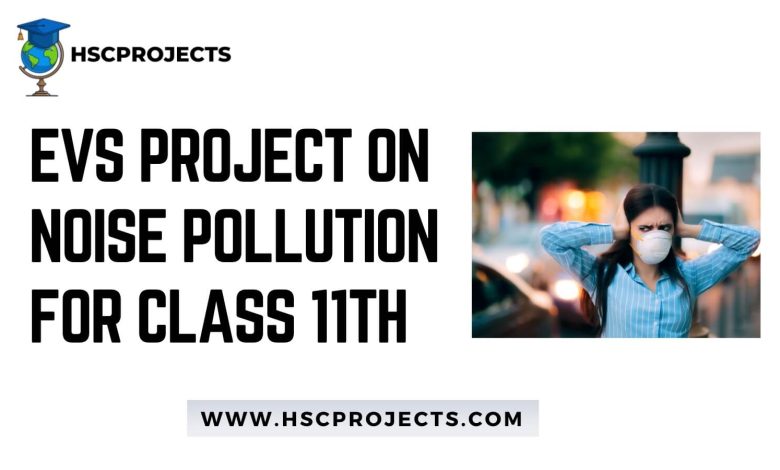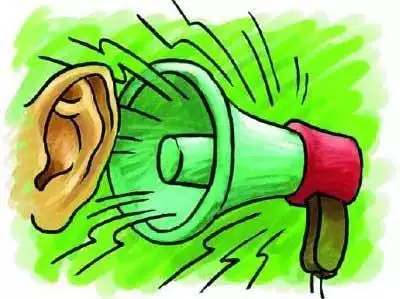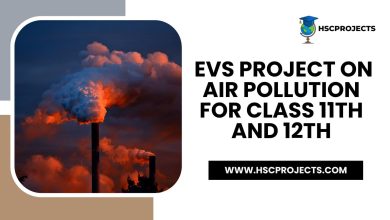
Evs Project On Noise Pollution For Class 11th
Acknowledgement:
I would like to extend my heartfelt gratitude and appreciation to my esteemed Environmental Science teacher, [Name], for their invaluable guidance, support, and encouragement during the completion of this project on Noise Pollution.
[Name]’s expertise in the field of environmental science has been instrumental in shaping the direction and content of this project. Their profound knowledge and passion for the subject have inspired and motivated me to delve deeper into the topic of noise pollution and its impact on our surroundings.Throughout the project, [Name] has provided me with valuable insights and suggestions, helping me refine my research methodology and analysis. Their constructive feedback and guidance have been invaluable in ensuring the accuracy and comprehensiveness of the project.
I would also like to express my gratitude to [Name] for their unwavering support and belief in my abilities. Their constant encouragement has instilled confidence in me and has been pivotal in overcoming challenges during the project’s completion.
Additionally, I would like to thank my classmates and friends who have assisted me in gathering data and providing valuable inputs during the project’s development. Their collaboration and enthusiasm have enriched the overall quality of this project.
Last but not least, I am deeply grateful to my family for their unwavering support and understanding. Their encouragement and patience have been vital in enabling me to dedicate the necessary time and effort to complete this project successfully.
Once again, I express my deepest gratitude to [Name] and all those who have contributed to the realization of this project on Noise Pollution. Your guidance, support, and encouragement have been indispensable, and I am truly grateful for the opportunity to work on this project under your supervision.
Introduction to Noise Pollution:
Noise pollution is a widespread environmental problem that arises from various sources and has adverse effects on both human health and the environment. It is characterized by excessive or disturbing sounds that disrupt the normal balance of the acoustic environment.
Noise pollution is generated by numerous activities and sources in our daily lives. Transportation, including vehicles on roads, trains, airplanes, and ships, is a major contributor to noise pollution. The constant honking of horns, engine noises, and the sonic boom of airplanes create a high level of noise, particularly in urban areas.
Industrial activities, such as manufacturing processes, power plants, and construction sites, also generate significant amounts of noise. The operation of machinery, heavy equipment, and power tools produces loud and continuous sounds, which can impact both workers and nearby communities.
Construction activities, including drilling, hammering, and demolition work, contribute to noise pollution as well. These activities often take place in residential areas, leading to disturbance and inconvenience for the residents.
Recreational activities can also generate noise pollution, especially in crowded areas. Events like concerts, sporting events, and festivals produce loud music, cheering crowds, and amplified announcements, causing discomfort and potential harm to individuals.
The excessive exposure to noise pollution can have detrimental effects on human health. Prolonged exposure to high levels of noise can lead to hearing loss and damage to the auditory system. It can also cause annoyance, stress, and sleep disturbances, leading to psychological issues such as anxiety, irritability, and reduced concentration.
Furthermore, noise pollution has negative impacts on the environment. It disrupts the natural habitats of wildlife, affecting their behavior, feeding patterns, and reproductive activities. For example, noise pollution from ships and sonar activities can disturb marine animals, leading to changes in migration patterns and communication difficulties.
In conclusion, noise pollution is a pervasive problem resulting from various sources such as transportation, industrial activities, construction, and recreational events. Its detrimental effects on human health and the environment make it a matter of concern that requires attention and effective mitigation strategies. By understanding the causes and consequences of noise pollution, we can work towards creating a quieter and healthier environment for all.

Example of Noise Pollution:
Noise pollution manifests in various forms and can be observed in numerous everyday situations. Two prominent examples of noise pollution are the incessant honking of vehicles in urban areas and the noise generated by construction sites.
In urban areas, the constant honking of vehicles has become a significant source of noise pollution. The honking is primarily due to traffic congestion, aggressive driving behavior, or lack of adherence to traffic rules. The cumulative effect of honking horns from cars, motorcycles, and buses creates a chaotic and stressful environment. Pedestrians, motorists, and residents in the vicinity are exposed to high levels of noise, leading to increased stress levels, annoyance, and a reduced quality of life. Prolonged exposure to such noise pollution can also have long-term impacts on individuals’ hearing abilities, potentially resulting in hearing loss or other auditory issues.
Another notable example of noise pollution is the noise generated by construction sites. Construction activities involve the use of heavy machinery, such as excavators, bulldozers, jackhammers, and concrete mixers, which emit high-intensity noise. The continuous operation of these machines, especially in densely populated areas, can cause significant disturbance and inconvenience to nearby communities. Construction noise disrupts the peace and tranquility of the surroundings, affecting residents’ sleep patterns, concentration levels, and overall well-being. It can also impact vulnerable populations, such as the elderly, young children, and individuals with certain medical conditions.
These examples highlight how noise pollution can arise from common activities and significantly impact individuals and communities. The incessant honking of vehicles in urban areas and the noise generated by construction sites are just a few instances of the widespread issue of noise pollution. It is crucial to address these sources of noise pollution through effective regulations, soundproofing measures, and responsible behavior to ensure a healthier and more peaceful living environment for everyone.
Importance of EVS Project on Noise Pollution:
The EVS project on Noise Pollution holds significant importance for several reasons. Firstly, it raises awareness among individuals about the adverse effects of noise pollution on human health and the environment. By understanding its consequences, people can take necessary measures to minimize their contribution to noise pollution and protect themselves. Secondly, the project highlights the need for effective policies and regulations to control and mitigate noise pollution. Lastly, it emphasizes the role of collective action and responsible behavior in reducing noise pollution and creating a more peaceful environment.

How Can We Make It Happen?
To effectively address noise pollution, we need a collective effort from individuals, communities, and governing bodies. Here are some steps that can be taken:
Public Awareness: Conduct awareness campaigns, seminars, and workshops to educate people about the causes and consequences of noise pollution. Encourage individuals to adopt soundproofing measures in their homes and workplaces.
Implement Noise Regulations: Enforce strict noise regulations and standards for industries, construction sites, and public places. These regulations should limit noise levels and define penalties for non-compliance.
Noise Reduction Measures: Encourage the use of noise-reducing technologies and techniques in transportation, construction, and industrial activities. Promote the adoption of quieter machinery and equipment.
Land Use Planning: Incorporate noise considerations into urban planning by ensuring the appropriate placement of residential areas, schools, and hospitals away from high-noise sources like highways or industrial zones.

The Three Pillars of Addressing Noise Pollution:
Prevention: Focus on reducing noise pollution at its source by employing quieter technologies, controlling noise emissions from industries, and promoting responsible behavior among individuals.
Protection: Implement measures to protect individuals from excessive noise exposure, such as providing sound barriers, noise barriers on highways, and soundproofing buildings near noisy areas.
Public Participation: Encourage active involvement of the public in raising concerns about noise pollution and participating in decision-making processes. Engage community organizations, NGOs, and citizen groups to work collaboratively in addressing noise pollution issues.
Conclusion:
In conclusion, noise pollution poses a significant threat to our environment, health, and overall well-being. Throughout this EVS project, we have delved into the causes, provided examples, and discussed the consequences of noise pollution. It has become evident that raising awareness and taking proactive measures are crucial to address this issue effectively.
Noise pollution is a multifaceted problem caused by various sources, including transportation, industrial activities, construction, and recreational events. It disrupts the harmony of our surroundings, leading to stress, annoyance, and potential health problems such as hearing loss, sleep disturbances, and psychological issues.
Raising awareness about noise pollution is essential. By educating ourselves and others about its causes and consequences, we can foster a sense of responsibility towards reducing noise pollution. Awareness campaigns, seminars, and workshops can play a pivotal role in disseminating information and encouraging individuals to take action.
Implementing effective measures to combat noise pollution requires a three-pronged approach: prevention, protection, and public participation.
Prevention involves addressing noise pollution at its source. This can be achieved by employing quieter technologies, promoting the use of noise-reducing equipment, and encouraging responsible behavior among individuals and industries.
Protection measures focus on safeguarding individuals from excessive noise exposure. Implementing sound barriers, noise barriers, and soundproofing measures in residential areas, schools, hospitals, and workplaces can significantly reduce the impact of noise pollution.
Public participation is crucial in creating a sustainable and peaceful environment. Encouraging active involvement from citizens, community organizations, NGOs, and other stakeholders fosters a sense of ownership and collective responsibility. By engaging in decision-making processes, raising concerns, and advocating for noise regulations and policies, individuals can contribute to meaningful change.
In conclusion, by working together and implementing the three pillars of prevention, protection, and public participation, we can make a positive impact in reducing noise pollution. It is essential for governments, organizations, communities, and individuals to collaborate and take action to create a more peaceful and sustainable environment for everyone.
As responsible citizens, we must recognize the detrimental effects of noise pollution and strive to minimize our contribution to it. Let us work towards a future where tranquility and harmony prevail, promoting a healthier and more enjoyable quality of life for ourselves and future generations.
Certificate of Completion
Certificate of Completion
[Student’s Name][Class/Grade Level]This is to certify that I, [Student’s Name], a [Class/Grade Level] student, have successfully completed the project on “Evs Project On Noise Pollution For Class 11th.” The project explores the fundamental principles and key aspects of the chosen topic, providing a comprehensive understanding of its significance and implications.
In this project, I delved into in-depth research and analysis, investigating various facets and relevant theories related to the chosen topic. I demonstrated dedication, diligence, and a high level of sincerity throughout the project’s completion.
Key Achievements:
Thoroughly researched and analyzed Evs Project On Noise Pollution For Class 11th.
Examined the historical background and evolution of the subject matter.
Explored the contributions of notable figures in the field.
Investigated the key theories and principles associated with the topic.
Discussed practical applications and real-world implications.
Considered critical viewpoints and alternative theories, fostering a well-rounded understanding.
This project has significantly enhanced my knowledge and critical thinking skills in the chosen field of study. It reflects my commitment to academic excellence and the pursuit of knowledge.
Date: [Date of Completion]Signature: [Your Signature] [School/Institution Name][Teacher’s/Examiner’s Name and Signature]
In order to download the PDF, You must follow on Youtube. Once done, Click on Submit
Follow On YoutubeSubscribed? Click on Confirm
Download Evs Project On Noise Pollution For Class 11th PDF






